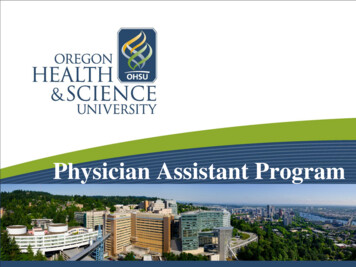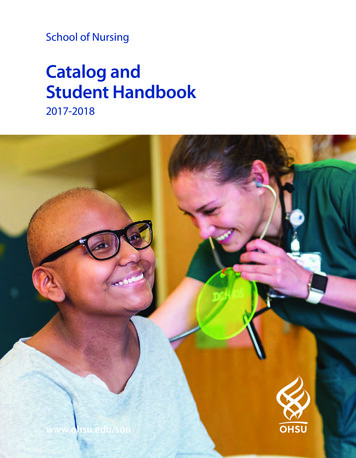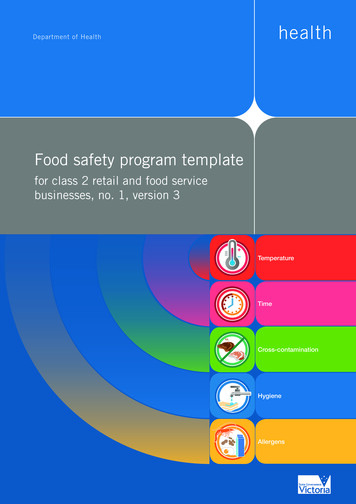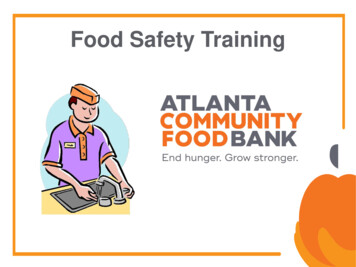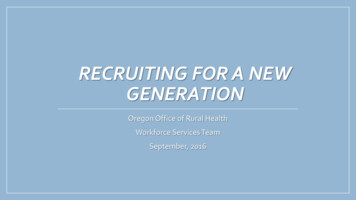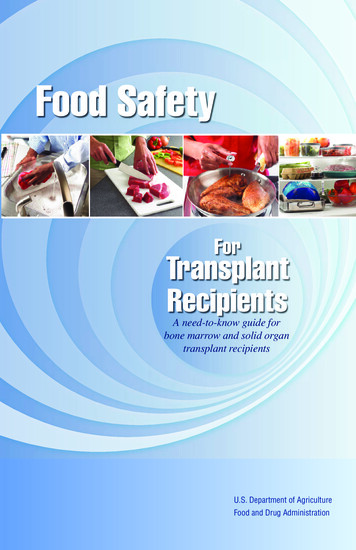
Transcription
Food SafetyForTransplantRecipientsA need-to-know guide forbone marrow and solid organtransplant recipientsU.S. Department of AgricultureFood and Drug Administration
Thank you to Lydia Medeiros, Ph.D., R.D., Patricia A. Kendall,Ph.D., R.D., and Val Hillers, Ph.D., R.D., for their assistance andgroundbreaking research and outreach to the at-risk community.
Food safety is important for everyone—but it’sespecially important for you. That’s why theU.S. Department of Agriculture’s Food Safetyand Inspection Service and the U.S. Departmentof Health and Human Services’ Food and DrugAdministration have prepared this booklet.It is designed to provide practical guidance onhow to reduce your risk of foodborne illness.In addition to this guide, we encourage you tocheck with your physician or health care providerto identify foods and other products that you shouldavoid. You have a special need for this importantinformation . . . so read on!
What’s Inside:Food Safety: It’s Especially Important for You. 3Major Pathogens That Cause Foodborne Illness .4-5Eating at Home: Making Wise Food Choices. 6Common Foods: Select the Lower Risk Options. 7Taking Care: Handling and Preparing Food Safely .8-10Cold Storage Chart . 11In the Know: Becoming a Better Shopper . 12Food Product Dating . 13Transporting Your Groceries . 13Being Smart When Eating Out. 14Tips for Transporting Food. 15Foodborne Illness: Know the Symptoms . 16Foodborne Illness Action Plan . 17For More Information on Food Safety. 18Additional Food Safety Resources . 19Check out the handy Check Your Steps Clip-out Info Cards between pages10 and 11 of this booklet!Foodborne Illness in the United StatesWhen certain disease-causing bacteria, viruses or parasites contaminatefood, they can cause foodborne illness. Another word for such a bacteria,virus, or parasite is “pathogen.” Foodborne illness, often called food poisoning, is an illness that comes from a food you eat. The food supply in the United States is among the safest in the world—but it can still be a source of infection for all persons. According to the Centers for Disease Control and Prevention, 48 millionpersons get sick, 128,000 are hospitalized, and 3,000 die from foodborneinfection and illness in the United States each year. Many of these peopleare children, older adults, or have weakened immune systems and may notbe able to fight infection normally.Since foodborne illness can be serious—or even fatal—it is important foryou to know and practice safe food-handling behaviors to help reduce yourrisk of getting sick from contaminated food.2
Food Safety:It’s Especially Important for YouAs a transplant recipient, you are probably familiar with the topic oftransplant rejection. It’s the body’s natural reaction or immune system’sresponse to “foreign invasion.” A properly functioning immune system will try to reject or destroyyour new solid organ and/or bone marrow transplant—in the same waythat your immune system works to clear infection from your body. Because of this natural rejection possibility, it’s common for transplantrecipients to take medications to keep rejection from happening.These drugs are called immunosuppressive medications because theysuppress your immune system to keep it from attacking, or rejecting,your transplanted organ or bone marrow. Overthe past few decades, substantial progress hasbeen made in the development of these drugsthat help prevent you from experiencing atransplant rejection. Immunosuppressive medications are important,as they can protect your transplanted solid organand/or bone marrow. But a side effect of theseimmunosuppressants is that they leave youmore susceptible to developing infections—like those that can be brought on by diseasecausing bacteria and other pathogens that causefoodborne illness. Because you are a transplant recipient, you aremore likely to have a lengthier illness, undergohospitalization, or even die, should you contract a foodborne illness. To avoid contracting a foodborne illness, you must be especiallyvigilant when handling, preparing, and consuming foods.Make safe food handling a lifelong commitmentto minimize your risk of foodborne illness.Be aware that as you age, your immunityto infection naturally is weakened.3
Major Pathogens That Cause Foodborne IllnessCampylobacterAssociated Foods Untreated or contaminated water Unpasteurized (“raw”) milk Raw or undercooked meat,poultry, or shellfishCryptosporidiumAssociated Foods/Sources Swallowing contaminated water,including that from recreationalsources, (e.g., a swimming poolor lake) Eating uncooked orcontaminated food Placing a contaminated object inthe mouth Soil, food, water, andcontaminated surfacesClostridium perfringensAssociated Foods/Sources Many outbreaks result from foodleft for long periods in steamtables or at room temperatureand time and/or temperatureabused foods. Meats, meat products, poultry,poultry products, and gravySymptoms and Potential Impact Fever, headache, and muscle pain followed bydiarrhea (sometimes bloody), abdominal pain,and nausea. Symptoms appear 2 to 5 days aftereating and may last 2 to 10 days. May spreadto the bloodstream and cause a life-threateninginfection.Symptoms and Potential Impact Watery diarrhea, dehydration, weight loss,stomach cramps or pain, fever, nausea, andvomiting; respiratory symptoms may also bepresent. Symptoms begin 7 to 10 days after becominginfected, and may last 2 to 14 days. In thosewith a weakened immune system, includingbone marrow and solid organ transplantrecipients, symptoms may subside and returnover weeks to months.Symptoms and Potential Impact Onset of watery diarrhea and abdominalcramps within about 16 hours. The illnessusually begins suddenly and lasts for 12 to24 hours. In the elderly, symptoms may last1 to 2 weeks. Complications and/or death occur only veryrarely.Listeria monocytogenesCan grow slowly at refrigerator temperaturesAssociated Foods Improperly reheated hot dogs,luncheon meats, cold cuts,fermented or dry sausage,and other deli-style meat andpoultry Unpasteurized (raw) milkand soft cheeses made withunpasteurized (raw) milk Smoked seafood and saladsmade in the store such as hamsalad, chicken salad, or seafoodsalads Raw vegetablesSymptoms and Potential Impact Fever, chills, headache, backache, sometimesupset stomach, abdominal pain, and diarrhea.May take up to 2 months to become ill. Gastrointestinal symptoms may appear within a fewhours or 2 to 3 days, and disease may appear 2 to 6weeks after ingestion. The duration is variable. Those at-risk (including bone marrow and solidorgan transplant recipients and others withweakened immune systems) may later developmore serious illness; death can result from thisbacteria. Can cause problems with pregnancy, includingmiscarriage, fetal death, or severe illness or deathin newborns.4
Escherichia coli O157:H7One of several strains of E. coli that can cause human illnessAssociated Foods Undercooked beef,especially hamburger Unpasteurized milk and juices,like “fresh” apple cider Contaminated raw fruits andvegetables, and water Person-to-person contactSymptoms and Potential Impact Severe diarrhea that is often bloody,abdominal cramps, and vomiting.Usually little or no fever. Can begin 1 to 9 days after contaminated foodis eaten and lasts about 2 to 9 days. Some, especially the very young, maydevelop hemolytic-uremic syndrome (HUS),which can cause acute kidney failure, and canlead to permanent kidney damage or even death.Noroviruses (and other caliciviruses)Associated Foods Shellfish and fecallycontaminated foods or water Ready-to-eat foods touchedby infected food workers; forexample, salads, sandwiches,ice, cookies, fruitSalmonella (over 2,300 types)Associated Foods Raw or undercooked eggs,poultry, and meat Unpasteurized (raw) milk orjuice Cheese and seafood Fresh fruits and vegetablesToxoplasma gondiiAssociated Foods/Sources Accidental contact of cat fecesthrough touching hands tomouth after gardening, handlingcats, cleaning cat’s litter box, ortouching anything that has comein contact with cat feces. Raw or undercooked meat.Vibrio vulnificusAssociated Foods Undercooked or raw seafood(fish or shellfish)Symptoms and Potential Impact Nausea, vomiting, and stomach pain usuallystart between 24 and 48 hours, but casescan occur within 12 hours of exposure.Symptoms usually last 12 to 60 hours. Diarrhea is more prevalent in adults andvomiting is more prevalent in children.Symptoms and Potential Impact Stomach pain, diarrhea (can be bloody),nausea, chills, fever, and/or headache usuallyappear 6 to 72 hours after eating; may last 4to 7 days. In people with a weakened immune system,such as bone marrow and solid organ transplantrecipients the infection may be more severe andlead to serious complications including death.Symptoms and Potential Impact Flu-like illness that usually appears 10 to 13days after eating, may last months. Those witha weakened immune system, including bonemarrow and solid organ transplant recipients,may develop more serious illness. Can cause problems with pregnancy, includingmiscarriage and birth defects.Symptoms and Potential Impact Diarrhea, stomach pain, and vomiting may appearwithin 4 hours and to several days and last 2 to8 days. May result in a blood infection. Mayresult in death for those with a weakened immunesystem, including people with bone marrow andsolid organ transplants, cancer or liver disease.5
Eating at Home:Making Wise Food ChoicesSome foods are more risky for you thanothers. In general, the foods that are mostlikely to contain harmful bacteria orviruses fall into two categories: Uncooked fresh fruits andvegetables Some animal products, suchas unpasteurized (raw) milk; softcheeses made with raw milk; andraw or undercooked eggs, rawmeat, raw poultry, raw fish, rawshellfish and their juices; luncheonmeats and deli-type salads (withoutadded preservatives) prepared on sitein a deli-type establishment.Interestingly, the risk these foodsmay actually pose depends on the originor source of the food and how the food isprocessed, stored, and prepared. Follow theseguidelines (see chart at right) for safe selectionand preparation of your favorite foods.If You Have Questions . . . . . about Wise Food Choices:Be sure to consult with your doctor or health care provider. He or shecan answer any specific questions or help you in your choices. . . about Particular Foods:KEEP YOUR FAMILY SAFER FROM FOOD POISONINGIf you are not sure about the safetyof a food in your refrigerator,don’t take therisk.When in doubt, throw it out!Wise choices in your food selectionsare important.SEPARATEWASH HANDS ANDSURFACES OFTENSEPARATE RAW MEATSFROM OTHER FOODSCHILLºFAll consumers need to follow the FourBasic Steps to Food Safety:Clean, Separate, Cook, and Chill.CLEANCLEAN6SEPARATECOOK TO THE RIGHTTEMPERATUREREFRIGERATE FOODPROMPTLYCheck your steps at FoodSafety.govCHILL
Common Foods: Select the Lower Risk OptionsType of FoodHigher RiskLower RiskMeat andPoultry Raw or undercookedmeat or poultrySeafood Any raw or undercooked fish, or Previously cooked seafoodshellfish, or food containing raw orheated to 165 Fundercooked seafood e.g., sashimi, Canned fish and seafoodfound in some sushi or ceviche. Seafood cooked to 145 FRefrigerated smoked fish Partially cooked seafood, such asshrimp and crabMilkEggs Unpasteurized (raw) milk Pasteurized milkSprouts Raw sprouts (alfalfa, bean, orany other sprout) Cooked sprouts Unwashed fresh vegetables,including lettuce/salads Washed fresh vegetables,including salads Cooked vegetablesCheese Soft cheeses made fromunpasteurized (raw) milk, such as:— Feta— Brie— Camembert— Blue-veined— Queso fresco Hot Dogs andDeli Meats Hot dogs, deli meats, andluncheon meats that have notbeen reheated Hot dogs, luncheon meats,and deli meats reheated tosteaming hot or 165 F Meat or poultry cooked to asafe minimum internal temperature (see chart on p. 10)Tip: Use a food thermometer to check the internal temperature on the “Is It DoneYet?” chart on page 10 for specific safe minimum internal temperature.Foods that contain raw/undercooked At home:eggs, such as: Use pasteurized eggs/eggproducts when preparing Homemade Caesar salad dressings*recipes that call for raw or Homemade raw cookie dough*undercooked eggs Homemade eggnog*When eating out: Ask if pasteurized eggswere used*Tip: Most pre-made foods from grocery stores, such as Caesar dressing,pre-made cookie dough, or packaged eggnog are made with pasteurized eggs.VegetablesHard cheesesProcessed cheesesCream cheeseMozzarellaSoft cheeses that areclearly labeled “made frompasteurized milk”Tip: You need to reheat hot dogs, deli meats, and luncheon meats before eating them because the bacteriaListeria monocytogenes grows at refrigerated temperatures (40 F or below). This bacteria may causesevere illness, hospitalization, or even death. Reheating these foods until they are steaming hotdestroys these dangerous bacteria and makes these foods safe for you to eat.Pâtés Unpasteurized, refrigeratedpâtés or meat spreads7 Canned or shelf-stablepâtés or meat spreads
Taking Care:Handling and Preparing Food SafelyFoodborne pathogens are sneaky. Food that appears completely fine can containpathogens—disease-causing bacteria, viruses, or parasites—that can make yousick. You should never taste a food to determine if it is safe to eat.As a transplant recipient, it is especiallyimportant that you—or those preparingyour food—are always careful with foodhandling and preparation. The easiest wayto do this is to Check Your Steps – clean,separate, cook, and chill – from the FoodSafe Families Campaign.Four Basic Steps to Food Safety1. Clean: Wash hands and surfaces oftenBacteria can spread throughout the kitchen and get ontocutting boards, utensils, counter tops, and food.To ensure that your hands and surfaces are clean,be sure to: Wash hands in warm soapy water for at least 20 seconds before andafter handling food and after using the bathroom, changing diapers, orhandling pets. Wash cutting boards, dishes, utensils, and counter tops with hot soapy water between the preparation of raw meat, poultry, and seafood products and preparationof any other food that will not be cooked. As an added precaution, sanitize cutting boards and countertops by rinsing them in a solution made of one tablespoonof unscented liquid chlorine bleach per gallon of water, or, as an alternative, youmay run the plastic board through the wash cycle in your automatic dishwasher. Use paper towels to clean up kitchen surfaces. If using clothtowels, you should wash them often in the hot cycle of the washing machine. Wash produce. Rinse fruits and vegetables, and rub firm-skin fruits andvegetables under running tap water, including those with skins and rindsthat are not eaten. With canned goods: remember to clean lids before opening.8
2. Separate: Don’t cross-contaminateCross-contamination occurs when bacteria are spreadfrom one food product to another. This is especiallycommon when handling raw meat, poultry, seafood,and eggs. The key is to keep these foods—and theirjuices—away from ready-to-eat foods.To prevent cross-contamination, remember to: Separate raw meat, poultry, seafood, and eggs from other foods in yourgrocery shopping cart, grocery bags, and in your refrigerator. Never place cooked food on a plate that previously held raw meat,poultry, seafood, or eggs without first washing the plate with hot soapy water. Don’t reuse marinades used on raw foods unless you bring them to a boil first. Consider using one cutting board only for raw foods and another only forready-to-eat foods, such as bread, fresh fruits and vegetables, and cooked meat.3. Cook: Cook to safe temperaturesFoods are safely cooked when they are heated to theUSDA-FDA recommended safe minimum internaltemperatures, as shown on the “Is It Done Yet?” chart(see next page).To ensure that your foods are cooked safely, always: Use a food thermometer to measure the internal temperature of cooked foods.Check the internal temperature in several places to make sure that the meat, poultry, seafood, or egg product is cooked to safe minimum internal temperatures. Cook ground beef to at least 160 F and ground poultry to a safe minimuminternal temperature of 165 F. Color of food is not a reliable indicator of safetyor doneness. Reheat fully cooked hams packaged at a USDA-inspected plant to 140 F. Forfully cooked ham that has been repackaged in any other location or for leftoverfully cooked ham, heat to 165 F. Cook seafood to 145 F. Cook shrimp, lobster, and crab until they turn red andthe flesh is pearly opaque. Cook clams, mussels, and oysters until the shellsopen. If the shells do not open, do not eat the seafood inside. Cook eggs until the yolks and whites are firm. Use only recipes in which the eggsare cooked or heated to 160 F. Cook all raw beef, lamb, pork, and veal steaks, roasts, and chops to 145 Fwith a 3-minute rest time after removal from the heat source.9
3. Cook: Cook to safe temperatures (cont.) Bring sauces, soups, and gravy to a boil when reheating. Heat other leftoversto 165 F. Reheat hotdogs, luncheon meats, bologna, and other deli meats until steaming hot or 165 F When cooking in a microwave oven, cover food, stir, and rotate for evencooking. If there is no turntable, rotate the dish by hand once or twice duringcooking. Always allow standing time, which completes the cooking, beforechecking the internal temperature with a food thermometer. Food is done whenit reaches the USDA-FDA recommended safe minimum internal temperature.Is It Done Yet?Use a food thermometer to be most accurate. You can’t always tell by looking.USDA-FDA Recommended Safe Minimum Internal TemperaturesBeef, Pork, Veal, LambSteaks, Roasts & Chops145 Fwith 3-minuterest timeFish145 FBeef, Pork, Veal, LambGround160 FEgg Dishes160 FTurkey, Chicken & DuckWhole, Pieces & Ground165 F4. Chill: Refrigerate promptlyCold temperatures slow the growth of harmful bacteria. Keeping a constant refrigerator temperature of 40 F or below isone of the most effective ways to reduce risk of foodborneillness. Use an appliance thermometer to be sure the refrigerator temperature is consistently 40 F or below and the freezertemperature is 0 F or below.To chill foods properly: Refrigerate or freeze meat, poultry, eggs, seafood, and other perishables within2 hours of cooking or purchasing. Refrigerate within 1 hour if the temperatureoutside is above 90 F. Never thaw food at room temperature, such as on the counter top. It is safe tothaw food in the refrigerator, in cold water, or in the microwave. If you thawfood in cold water or in the microwave, you should cook it immediately. Divide large amounts of food into shallow containers for quicker coolingin the refrigerator. Follow the recommendations in the abridged USDA-FDA Cold Storage Chart(see page 11). The USDA-FDA Cold Storage Chart in its entirety may be foundat www.fsis.usda.gov/Fact Sheets/Refrigeration & Food Safety/index.asp.10
USDA-FDA Cold Storage ChartThese time limit guidelines will help keep refrigerated food safe to eat. Becausefreezing keeps food safe indefinitely, recommended storage times for frozen foodsare for quality only.EggsProductRefrigerator (40 F)Freezer (0 F)Fresh, in shellHard cooked3 to 5 weeks1 weekDon’t freezeDon’t freeze wellOpenedUnopened3 days10 daysDon’t freeze well1 yearEgg, chicken, ham, tuna,& macaroni salads3 to 5 daysDon’t freeze well1 week2 weeks1 to 2 months1 to 2 monthsOpened packageUnopened package3 to 5 days2 weeks1 to 2 months1 to 2 monthsBaconSausage, raw—fromchicken, turkey, pork, beef7 days1 month1 to 2 days1 to 2 monthsHamburger, ground beef,turkey, veal, pork, lamb, &mixtures of them1 to 2 days3 to 4 monthsSteaksChopsRoasts3 to 5 days3 to 5 days3 to 5 days6 to 12 months4 to 6 months4 to 12 monthsChicken or turkey, wholeChicken or turkey, pieces1 to 2 days1 to 2 days1 year9 monthsLean fish (flounder, haddock,halibut, etc.)Fatty fish (salmon, tuna, etc.)1 to 2 days1 to 2 days6 to 8 months2 to 3 monthsCooked meat or poultryChicken nuggets, pattiesPizza3 to 4 days3 to 4 days3 to 4 days2 to 6 months1 to 3 months1 to 2 monthsLiquid Pasteurized Eggs, Egg SubstitutesDeli and Vacuum-Packed ProductsHot DogsOpened packageUnopened packageLuncheon MeatBacon & SausageHamburger and Other Ground MeatsFresh Beef, Veal, Lamb, PorkFresh PoultrySeafoodLeftovers
Clip out these handy Info Cards and carry them for quick reference when shopping, cooking, and eating out!Check Your Steps Check “Sell-By” date Put raw meat, poultry, or seafood inplastic bags Buy only pasteurized milk, soft cheesesmade with pasteurized milk, and pasteurizedor juices that have been otherwise treated tocontrol harmful bacteria. When buying eggs:– Purchase refrigerated shell eggs– If your recipe calls for raw eggs, purchasepasteurized, refrigerated liquid eggs Don’t buy food displayed in unsafe orunclean conditionsIs It Done Yet?You can’t tell by looking. Use a food thermometer to be sure.USDA-FDA Recommended Safe Minimum Internal TemperaturesBeef, Pork, Veal, LambSteaks, Roasts & Chops145 Fwith 3-minuterest timeFish145 FBeef, Pork, Veal, LambGround160 FEgg Dishes160 FTurkey, Chicken & DuckWhole, Pieces & Ground165 FOrdering “Smart” When Eating OutHigher Risk: Cheese made fromunpasteurized (raw) milk. Raw or undercookedseafood. Cold hot dogs. Sandwiches with cold delior luncheon meat. Raw or undercooked fish,such as sashimi or somekind of sushi. Soft-boiled or “over-easy”eggs, as the yolks are notfully cooked.Lower Risk: Hard or processed cheeses. Soft cheesesonly if made from pasteurized milk. Fully cooked smoked fish or seafood. Hot dogs reheated to steaming hot. If thehot dogs are served cold or lukewarm,ask to have the hot dogs reheated untilsteaming, or else choose something else. Grilled sandwiches in which the meat orpoultry is heated until steaming. Fully cooked fish that is firm and flaky;vegetarian sushi. Fully cooked eggs with firm yolk andwhites.
In the Know:Becoming a Better ShopperFollow these safe food-handlingpractices while you shop. Carefully read food labels whilein the store to make sure foodis not past its “sell by” date.(See Food Product Datingon page 13) Put raw packaged meat,poultry, or seafood into aplastic bag before placing itin the shopping cart, so thatits juices will not drip on—and contaminate—other foods.If the meat counter does not offerplastic bags, pick some up fromthe produce section before you selectyour meat, poultry, and seafood. Buy only pasteurized milk,cheese, and other dairy productsfrom the refrigerated section. When buying fruit juice from therefrigerated section of the store, be sure that the juice label says it ispasteurized. Purchase eggs in the shell from the refrigerated section of the store.(Note: store the eggs in their original carton in the main part of yourrefrigerator once you are home.) For recipes that call for eggs that areraw or undercooked when the dish is served—homemade Caesar saladdressing and ice cream are two examples—use either shell eggs that havebeen treated to destroy Salmonella by pasteurization, or pasteurized eggproducts. When consuming raw eggs, using pasteurized eggs is the saferchoice. Never buy food that is displayed in unsafe or unclean conditions. When purchasing canned goods, make sure that they are free of dents,cracks, or bulging lids. (Once you are home, remember to clean each lidbefore opening the can.) Purchase produce that is not bruised or damaged.When shopping for food,it is important to read the label carefully.12
Food Product DatingRead the “Safe Handling Label” for food safety information onraw foods.Types of Open DatesOpen dating is found primarily on perishable foods such as meat,poultry, eggs, and dairy products. A “Sell-By” date tells the store howlong to display the product for sale. Youshould buy the product before the dateexpires. A “Best If Used By (or Before)” date isrecommended for best flavor or quality.It is not a purchase or safety date. A “Use-By” date is the last daterecommended for the use of the productwhile at peak quality. The date has beendetermined by the manufacturer of theproduct.CHICKEN SAMPLER PACKJAN 13.06SELL BYPRICE/LB1.99270567005093576NET WT LB2.56 lbMEAT DEPT. 5.09TOTAL PRICEP—7903BEST IF USED BY10 NOV 06“Closed or coded dates” are packing numbers for use by themanufacturer. “Closed” or “coded” dating might appear on shelf-stableproducts such as cans and boxes of food.Transporting Your GroceriesFollow these tips for safe transportingof your groceries: Pick up perishable foods last, andplan to go directly home from thegrocery store. Always refrigerate perishable foodswithin 2 hours of cooking orpurchasing. Refrigerate within 1 hour if thetemperature outside is above 90 F. In hot weather, take a cooler with iceor another cold source to transportfoods safely.13
Being SmartWhen Eating OutEating out can be lots of fun—somake it an enjoyable experienceby following some simpleguidelines to avoid foodborne illness. Rememberto observe your foodwhen it is served, anddon’t ever hesitate to askquestions before you order.Waiters and waitresses canbe quite helpful if you ask how afood is prepared. Also, let them knowyou don’t want any food item containingraw meat, poultry, seafood, sprouts, or eggs.Basic Rules for Ordering Ask whether the food contains uncooked ingredients such as eggs,sprouts, meat, poultry, or seafood. If so, choose something else. Ask how these foods have been cooked. If the server does not knowthe answer, ask to speak to the chef to be sure your food has beencooked to a safe minimum internal temperature. If you plan to get a “doggy bag” or save leftovers to eat at a later time,refrigerate perishable foods as soon as possible—and always within2 hours after purchase or delivery. If the leftover food is in airtemperatures above 90 F, refrigerate it within 1 hour.If in doubt, make another selection!14
Smart Menu ChoicesHigher Risk: Soft cheese made fromunpasteurized (raw) milk.Lower Risk: Hard or processed cheeses. Soft cheesesonly if they are made from pasteurizedmilk. Refrigerated smoked seafood Fully cooked fish or seafood.and raw or undercooked seafood. Cold or improperly heated hotdogs. Hot dogs reheated to steaming hot.If the hot dogs are served cold orlukewarm, ask to have them reheated untilsteaming, or else choose something else. Sandwiches with cold delior luncheon meat. Grilled sandwiches in which the meator poultry is heated until steaming. Raw or undercooked fish, Fully cooked fish that is firm and flakysuch as sashimi, non-vegetariansushi, or cerviche. Soft-boiled or “over-easy”eggs, as the yolks are notfully cooked. Fully cooked eggs with firm yolk andwhites. Salads, wraps, or sandwichescontaining raw (uncooked) orlightly cooked sprouts Salads, wraps, or sandwiches containingcooked sprouts.Ask questions about how your food is cooked.Tips for Transporting Food Keep cold food cold, at 40 F or below. To be safest,place cold food in cooler with ice or frozen gel packs.Use plenty of ice or frozen gel packs. Cold foodshould be at 40 F or below the entire time you aretransporting it. Hot food should be kept hot at 140 F or above.Wrap the food well and place in an insulated container.Stay “Food Safe” When Traveling InternationallyDiscuss your travel plans with your physician before traveling to othercountries. Your physician may have specific recommendations for theplaces you are visiting, and may suggest extra precautions or medicationsto take on your travels.For more information about safe food and water while traveling abroad,access the Centers for Disease Control and Prevention Web site atwww.cdc.gov/travel.15
Foodborne Illness:Know the SymptomsDespite your best efforts, you may find yourself in a situation where yoususpect you have a foodborne illness. Foodborne illness often presentsitself with flu-like symptoms.These symptoms include: NauseaVomitingDiarrheaFeverIf you suspect that youcould have a foodborneillness, there are fourkey steps that you shouldtake. Follow the guidelinesin the Foodborne Illness ActionPlan on page 17, which beginswith contacting your physician orhealthcare provider right away.When in doubt—contact your physicianor healthcare provider!Name:Phone:Name:Phone:Name:Phone:My Physicians: Quick Reference ListSpecialty:Specialty:Specialty:16
Foodborne Illness Action PlanIf you suspect you have a foodborne illness,follow these general guidelines:1.Consult your transplant coordinator or physician, or seekmedical treatment as appropriate.As a transplant recipient on immunosuppressive medications,you are at increased risk for severe infection. Contact your physician immediately if you developsymptoms or think you may be at risk. If you develop signs of infection as discussed with yourphysician, seek out medical advice and/or treatme
. . . about Wise Food Choices: Be sure to consult with your doctor or health care provider. He or she can answer any speciic questions or help you in your choices. . . . about Particular Foods: If you are not sure about the safety of a food in your refrigerator, don't take therisk. When in doubt, throw it out! Wise choices in your food selections

